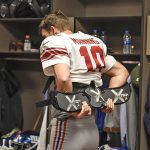Investors Turn to Sporting Goods in Tough Times
The old adage about the sporting goods industry weathering tough economic times got a real test last week. A first blush review of Wall Street results last week reveals that the industry did fare better than the market as a whole and many other sectors, but feedback from industry executives suggests that the tough economy and tight credit are having a real impact on many retailers.
As highlighted in the charts below, the Dow Jones Industrial Average ended up fairly flat against the previous week as Wall Street recovered late in the week after a tumultuous start. The S&P 500 managed to eke out a slight gain. Looking at the Sports Executive Weekly index of sporting goods industry stocks, the industry posted a 2.8% increase in value over the last week, led by strength in softgoods vendor stocks and specialty retail, tempered a bit by the hardlines business, which was more in the line with the S&P 500.
The departments store index did not fare as well as specialty retail, posting a mid-single-digit decline for the week.
Pacific Sunwear, Collective Brands, Cabelas, Volcom and Under Armour led all gainers for the week, and were joined by Columbia, Lululemon, Brown Shoe and Brunswick in posting double-digit stock share gains for the week.
Industry executives responding to the latest SportsOneSource SGB Question survey regarding the impact of the economic challenges facing the market provided a range of views from “no impact” to “were feeling it already.” The mood coming out of the most recent trade shows reveals much of the same, with larger retailers that rely on the middle to the lower end of the market experiencing more pain than those in the specialty markets.
When responding to the SGB Question about the impact of the recent Wall Street meltdown on consumer Holiday spending, specialty retailers were clearly more upbeat than their general sporting goods counterparts.
“For running specialty, very little,” said John Rogers, owner of Maine Running Co. in Portland, ME. “History has shown that consumers invest more in their health and well being when the economy softens.”
“Apparel may be affected,” continued Rogers, “but overall, the running specialty channel will continue to grow.”
That opinion differed from another specialty shop a little closer to the Wall Street pain.
That opinion differed from another specialty shop a little closer to the Wall Street pain.
“What the financial crisis will do is put a damper on all sales,” said Andy Kimerling, president of Westchester Road Runner in White Plains, NY. “The consumer will still buy necessities, like new shoes for a specific sport, but that same consumer will make do with last year’s clothing or make it last an extra season, if possible. Also, consumers will trade down in price.”
But Darren Bush, co-owner of Rutabaga Paddlesports in Monona, WI, strikes a much more positive tone.
“I think it all depends on geography,” said Bush. “Places that were spanked hard by the housing bubble (Arizona, Florida, etc.) might have a tougher time this year. Places that didnt experience the huge boom may not experience the huge bust. Were confident well have a good fall-winter, having already seen great August and September performance. Were doing the same advertising as before, which I am told will be more effective because of the people who are canceling their advertising and crawling into their shells to ride out the storm. Im optimistic.”
Outdoor specialty and running specialty retailers that have so far dodged the impact of rising gas prices and credit woes may finally see the investor class that dominates their consumer base pull back in response to shrinking 401(k) plans and other investments.
“It has and will impact overall consumer confidence and their willingness to set aside discretionary dollars on non-critical activities and wants versus needs,” said Kenny Ballard, CEO of Kelty, in response to the SGB Question. “Value and quality will be even more critical in the purchasing decision making process, as well as reliance on core, known consumer brands.”
“It pretty much goes without saying that the current state of some of our leading financial institutions will cause consumers at every income level to re-think their spending habits in general and the holiday buying season as it draws closer,” said Phil Peck, president of Westwind Sales Group. “Many consumers will be directly affected in loss of jobs, foreclosures, etc. and many will be thinking more seriously than ever about…their current money situation, which will result in more cautious spending unseen in many years.” Peck sees consumers purchasing holiday gifts that have a “higher use factor and/or perceived value and quality.”
Other key executives on the brand side indicated that despite already tight inventories, retailers were starting to cancel goods for fourth quarter in anticipation of a weaker Holiday selling season. Responses from some larger retailers appeared to indicate that they expect consumers to default toward known commodities and brands. Nike, Wilson, Under Armour, adidas and others are seen as safer bets by the big guys. Fringe brands may get pinched a bit.
With the economic factors weighing heavily on consumers minds and wallets, retailers should expect only a modest increase in holiday sales over the 2007 season, according to two forecasts released this past week. Deloittes Retail Group expects holiday sales, excluding motor vehicles and gasoline, to increase 2.5% to 3.0% during the November-to-January period, less than last years 3.4% increase, and one of the smallest gains since 1991s 2.0% gain.
Likewise, the TNS Retail Forward forecast predicts similar results – 1.5% growth – compared with 1.2% in 1991-for the holiday fourth quarter in the key holiday retail segments combined.
Department Stores Biggest Drag
TNS Forward anticipates that mass retailers will see a pickup in performance this holiday season as a result of a shift among shoppers toward value formats and the impact of higher food prices. The report forecasts 5.6% combined growth, nearly a full percentage point stronger than last year. Additionally, TNS Forward estimates that this years letup in retail sales will continue to take a toll on the softgoods sector this holiday season. Sales in the apparel and accessories channels are forecast to decline 1.3% in the aggregate in the holiday period compared with flat growth in 2007. Department stores, including the upscale players, will remain the biggest drag as upper-income households become increasingly vulnerable to economic pressures. Apparel and other specialty stores are expected to register flat growth this holiday season.












